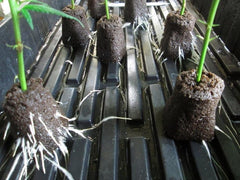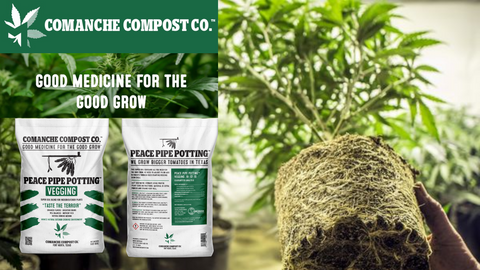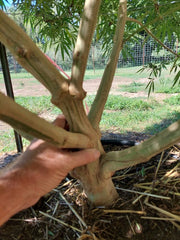Over 95% of all plants across the globe depend on a special type of mutually beneficial relationship created by an organism called mycorrhizae fungi. More specifically endomycorrhiza fungi, this variety of fungus uses intracellular penetration of the plant’s root by fungal filaments to help establish the relationship in the plant.

This relationship between the plants roots and “mycos” to pull moisture and nutrients they need from soil. These fascinating organisms facilitate the relationships between plants and the Fungi form a symbiotic partnership with some plants and algae and are actually responsible for the very survival of numerous species.[i] But how exactly does this relationship work? The question is what is Mycorrhizae and how do I get it in my soil media? We will answer these questions throughout this blog post and help you have a better understanding of the importance of this relationship below the soil horizon of your cannabis plants.
Mycorrhizae 101
Mycorrhizal fungi grow and spread through formations known as mycelium hyphae, which, due to their massive surface area create a network that spans throughout the whole soil media, allow for maximum nutrient absorption. The fungi present can also make it easier for plants to access key building blocks such as phosphorous and nitrogen which are paramount to optimal plant health, yield, size, and quality.[ii]
You’ve likely experienced the wonder of stumbling across some gorgeous fungi while out in the natural world. Whether it be the cartoonish red and white amanita muscaria [i] emerging from a downed log, fall leaf clutter or grass, it is a fruiting body of mycorrhizae that results in mushroom caps and other varieties alike.

Mycorrhizae facilitates the underground nutrition-gathering process that supports and replenishes the roots of plants during vegetative and flowering growth cycles to ensure the strongest and healthiest plants possible. The problem is that most soil doesn’t have enough mycorrhizae or any other beneficial soil organisms to help strengthen the plants root system and nutrient uptake. Biological activity in living soils contains both beneficial bacteria and mycorrhizae that help the plant grow.

When a cannabis plant has this beneficial and crucial relationship with also extends past nutrient uptake but rather the vigor, yield, and overall health of the plant. This phenomenon can also protect your plants against numerous threats that occur during the growing cycle. Mycorrhizae plants show increased resistance to pathogenic microbial diseases that occur within soil. They are also better equipped at combating drought conditions due to the vast development of hyphae that optimizes water uptake and are better at handling any salinity stresses that may occur during fertilization. They are also more resistant to certain toxicities that may occur in soils such as those with high metal concentrations.[i]

This function of fungi can be taken advantage of and used by growers to maximize the nutrient uptake of their plants and you can expect the following benefits and advantages in your cannabis cultivation. The benefits and advantages of mycorrhiza in cannabis cultivation are listed below in the table.
Benefits & Advantages of Mycorrhizae
Benefits of Mycorrhizae in Cannabis Cultivation:
|
Advantages of Mycorrhizae in Cannabis Cultivation:
|
Cannabis Cultivation & Mycorrhizae

Stronger, healthier plants require less maintenance and watering which saves you time and money. By utilizing a living soil by Comanche Compost that includes Wildroot Organic 16 species blend of mycorrhizae, will produce the healthiest, drought-tolerant plants with the strongest immune systems you could possibly grow with a developed root system. Our living soil helps create a beneficial environment for mycorrhizae.
By utilizing the Comanche Compost nutrient program, it can assist you to produce the most abundant, healthiest crops possible. Starting clean, utilizing organics and staying away from of synthetic fertilizers, pesticides and fungicides as they damage will allow you to have a healthy soil biome.
 Comanche Compost is a proprietary living soil blend that takes industrial coffee waste and turns it into soil for cultivating cannabis, vegetables, and horticultural plants. We only take organic ingredients that help you maintain a living soil that grows healthy plants and we have partnered with Wildroot Organic to ensure that every cubic foot of soil that we create has all 16 proprietary endomycorrhiza that can contribute to good medicine for that good grow. Wildroot Organic is a proprietary blend of mycorrhizae that helps solve the problem by boosting plant nutrient and water uptake with the added benefit of enhancing the plant’s natural immune system, organically.
Comanche Compost is a proprietary living soil blend that takes industrial coffee waste and turns it into soil for cultivating cannabis, vegetables, and horticultural plants. We only take organic ingredients that help you maintain a living soil that grows healthy plants and we have partnered with Wildroot Organic to ensure that every cubic foot of soil that we create has all 16 proprietary endomycorrhiza that can contribute to good medicine for that good grow. Wildroot Organic is a proprietary blend of mycorrhizae that helps solve the problem by boosting plant nutrient and water uptake with the added benefit of enhancing the plant’s natural immune system, organically.
Thanks for reading and if you have any questions about Comanche Compost’s products please click here and reach out to our team. We are serving Arizona, New Mexico, Oklahoma, and Texas markets right now commercial growers, grow stores, and hobby growers alike. Comanche Compost™ is a agricultural company founded on the idea of utilizing circular economics to create a commercial cannabis fertilizer that provides Good Medicine for The Good Grow.
Born out of necessity in North Texas to make sure we do our part in creating a sustainable future of soil utilizing in commercial cultivation of cannabis and turf grass through our parent company GeoJava.
Since 2017 we have created a living soil fertilizer solutions from composted commercial industrial cold brew coffee waste amended with the finest organic nutrients to create a living soil made for cultivating the finest cannabis through the vegetative stages indoors and outdoors.
[i]Benefits of Mycorrhiza: Enhanced plant efficiency in absorbing water and nutrients from the soil. Reducing fertility and irrigation requirements. Increased drought resistance. Increased pathogen resistance/protection. Enhancing plant health and vigor, and minimizing stress. Enhanced seedling growth. Enhanced rooting of cuttings. Enhanced plant transplant establishment. Improved phytoremediation of petroleum and heavy metal contaminated sites. Dr. Davies Research Page (tamu.edu)
[i] Arguably the most iconic toadstool species, the fly agaric is a large white-gilled, white-spotted, usually red mushroom, and is one of the most recognizable and widely encountered in popular culture. This includes video game design, such as the extensive use of a recognizable Amanita muscaria in the Mario franchise and its Super Mushroom power up. You can find an image of this iconic mushroom here Amanita muscaria – Wikipedia
[ii] Fungi are a fascinating life form, fundamental to all life on Earth. An interesting fact to many: Fungi are a totally independent kingdom of life, separate to that of animals and plants. However, they are genetically closer to animals than plants. How Fungi Can Make Your Cannabis Plants Prosper – RQS Blog (royalqueenseeds.com)
[i] Fungus, such as mushrooms, yeast, and mold, are eukaryotic, non-motile organisms that are heterotrophic, which means that they must take in nutrients for energy. They have cell walls made of chitin. The Evolution of Plants and Fungi: Characteristics & Evolutionary History – Video & Lesson Transcript | Study.com
